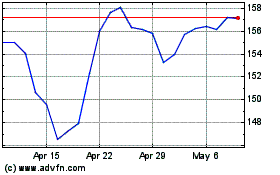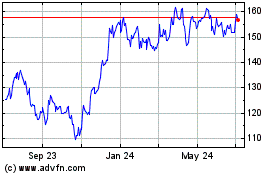Regional Bank Leaders Brush Off Yield Curve Worries
January 16 2019 - 4:25PM
Dow Jones News
By Allison Prang
Regional bank leaders on Wednesday talked up the strength of the
economy, even though the spread between long-term and short-term
lending has gotten smaller, a move that could lead the market to
worry the economy isn't far off from a recession.
From the end of the third quarter through mid-January, the yield
curve spread -- or the difference between 2-year and 10-year
Treasury yields -- has narrowed, compressing from about 24 basis
points at the end of September to about 18 basis points on Tuesday,
according to Dow Jones Market Data. During that more than
three-month period, the difference between the two yields hit a low
in mid-December at about 11 basis points.
Investors watch the yield curve closely as a gauge of the
profitability of their lending businesses. When the gap narrows, it
can erode the margins from borrowing at low short-term rates and
lending and higher long-term rates. An inversion of the yield curve
-- or when short-term rates are higher than long-term rates -- has
happened before every recession since at least 1975, according to
Dow Jones Market Data.
Even so, some of the country's largest regional banks aren't
that worried, even as financial stocks have taken a hit in recent
months along with the wider stock market.
U.S. Bancorp Chief Financial Officer Terry Dolan said in an
interview Wednesday that people tend to watch the yield curve as
the biggest indicator of when a recession is coming, but cautioned
that an inverted yield curve is one of a number of things that
would have to happen for the economy to turn. Those other factors
-- like less business spending or early consumer credit
delinquencies -- haven't happened.
"We see the yield curve and not really anything else," Mr. Dolan
said.
In PNC Financial Services Group Inc.'s fourth-quarter earnings
call on Wednesday, Chief Executive Bill Demchak noted the yield
curve's movements, but said PNC's corporate customers are "largely
bullish" still and that economic data from the Institute of Supply
Management measuring business activity shows expansion, even while
being off from its highs.
"We don't think we're headed towards a recession," Mr. Demchak
told analysts. "Consumer confidence remains high and it's going to
provide support for consumer spending."
He still cautioned that if the government shutdown continued for
a while or trade issues with China continue, the situation could
change, but added PNC didn't think that would happen.
"Instead, we see an economy growing at over 2.5% and healthy
loan demand as the repricing of the risk in the capital markets
drives business back to the banks," he said.
In reporting their fourth-quarter earnings results Wednesday,
both firms reported increases in their provisions for credit losses
from the comparable quarter a year ago. U.S. Bancorp's rose 9.9% to
$368 million and PNC's rose 18% to $148 million.
Mr. Dolan said the firm feels "really good" about credit
quality. The company's net charge-offs will increase seasonally in
the first part of 2019 but start to fall after that, he said.
Mr. Demchak said that PNC had four commercial loans change to
nonperforming assets during the quarter, but they were "associated
with strange things" and "nothing kind of based on the broader
economy." Chief Financial Officer Robert Reilly also said the
increase in the provision was partly because of loan growth.
"We don't see anything," Mr. Demchak said. "It just can't stay
... that low forever."
Write to Allison Prang at allison.prang@wsj.com
(END) Dow Jones Newswires
January 16, 2019 16:10 ET (21:10 GMT)
Copyright (c) 2019 Dow Jones & Company, Inc.
PNC Financial Services (NYSE:PNC)
Historical Stock Chart
From Mar 2024 to Apr 2024

PNC Financial Services (NYSE:PNC)
Historical Stock Chart
From Apr 2023 to Apr 2024
